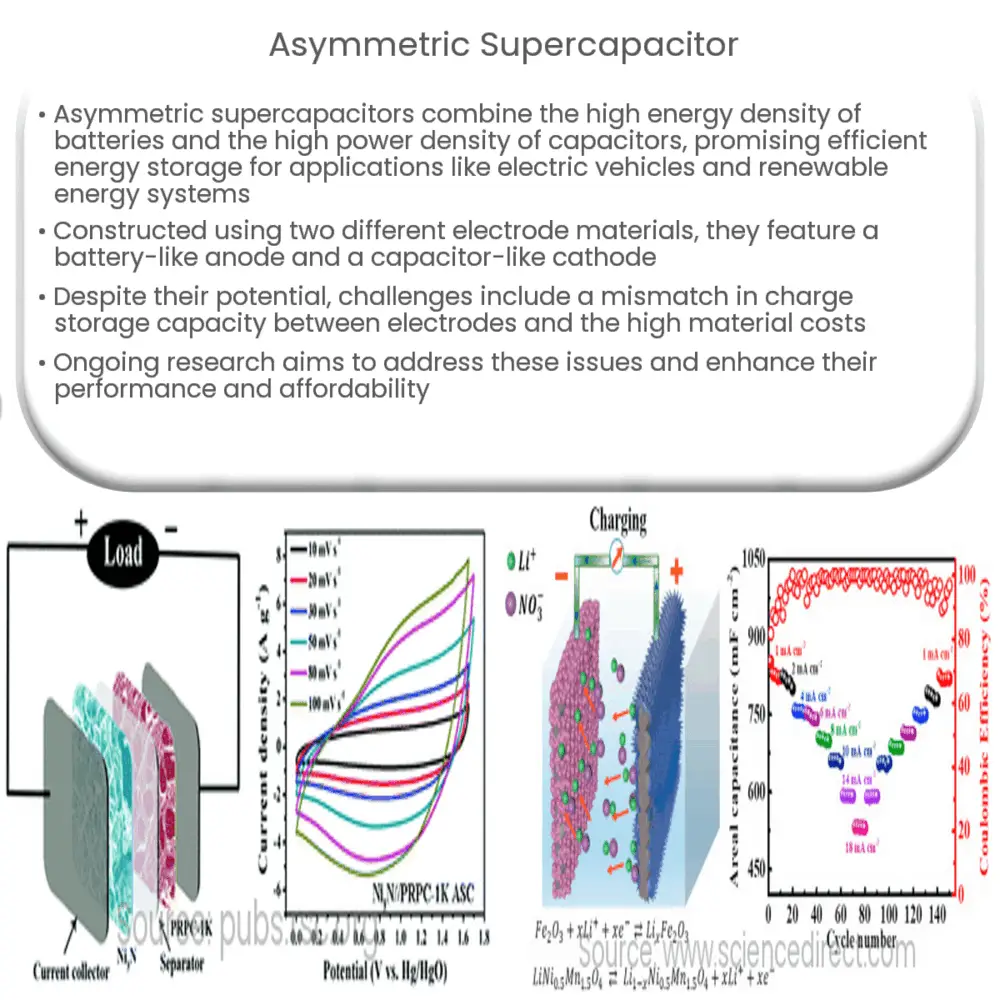Explore the potential of asymmetric supercapacitors, their structure, benefits, applications, challenges, and impact on future energy storage solutions.

Introduction to Asymmetric Supercapacitors
As we enter an era of renewable energy and electric vehicles, the need for high-performance energy storage devices has never been more critical. One such promising technology is the asymmetric supercapacitor, a high-capacity energy storage device that combines the best aspects of batteries and capacitors. These devices exhibit high energy density like batteries and high power density like capacitors, making them an ideal choice for a variety of applications.
Structure and Working Principle
Asymmetric supercapacitors, also known as hybrid supercapacitors, are constructed using two different electrode materials. Typically, one electrode has a high capacity for storing electric charge (like a battery), while the other can discharge the stored energy rapidly (like a capacitor).
- Anode: The anode, also known as the negative electrode, is typically made from a material with high energy density such as a transition metal oxide or a conductive polymer.
- Cathode: The cathode, or the positive electrode, is usually made from carbon-based materials like activated carbon, which have a high surface area and can discharge energy rapidly.
When an electric current is applied, ions from the electrolyte solution start to move towards the electrodes. At the anode, ions are absorbed, storing energy in the process. At the same time, the cathode releases these ions, delivering energy. This movement of ions creates an electric double layer, leading to the storage of energy.
Benefits of Asymmetric Supercapacitors
Asymmetric supercapacitors offer a unique combination of benefits, which make them an attractive option for energy storage:
- High energy density: Thanks to the battery-like anode, asymmetric supercapacitors can store a large amount of energy. This high energy density is particularly beneficial for applications that require sustained power delivery over a longer duration.
- High power density: The capacitor-like cathode allows for rapid discharge of energy, resulting in high power density. This is crucial for applications that require quick bursts of energy.
In the next section, we will delve deeper into the applications of asymmetric supercapacitors and explore some of the challenges that researchers are working to overcome to bring this promising technology to the mainstream market.
Applications of Asymmetric Supercapacitors
Given their impressive energy storage capabilities, asymmetric supercapacitors have a wide range of potential applications:
- Electric vehicles: Due to their high energy and power density, asymmetric supercapacitors can significantly improve the performance of electric vehicles, providing fast charging and discharging, thus enhancing acceleration and regenerative braking capabilities.
- Renewable energy systems: Asymmetric supercapacitors can provide efficient energy storage for intermittent renewable energy sources like solar and wind, allowing for better utilization of these green energy resources.
- Portable electronics: The high power density and long cycle life of asymmetric supercapacitors can also make them ideal for use in portable electronics such as mobile phones and laptops.
Challenges and the Future
Despite their potential, asymmetric supercapacitors still face several challenges that need to be overcome. One of the main challenges is the mismatch in the charge storage capacity between the two electrodes, which can limit the overall performance of the device. Researchers are currently exploring new materials and design strategies to address this issue.
Another challenge is the relatively high cost of the materials used in asymmetric supercapacitors. Efforts are being made to discover more cost-effective materials without compromising the performance of the device.
Conclusion
Asymmetric supercapacitors represent a significant advancement in energy storage technology, providing a balance between high energy density and high power density. Their unique features make them suitable for a broad spectrum of applications, from electric vehicles to renewable energy systems and portable electronics.
While challenges remain, ongoing research and development promise to overcome these hurdles, enhancing the performance and affordability of asymmetric supercapacitors. As we strive towards a more sustainable and energy-efficient future, it’s clear that asymmetric supercapacitors will play a crucial role in powering the technologies of tomorrow.

